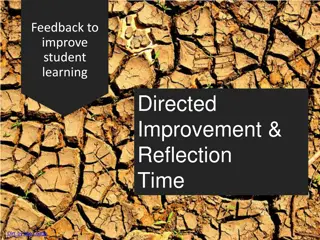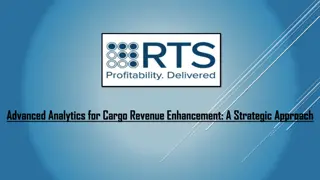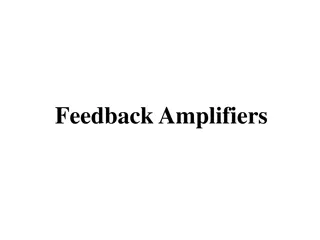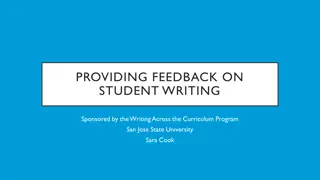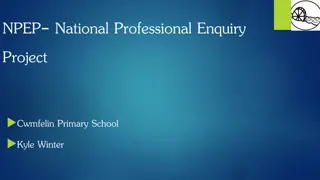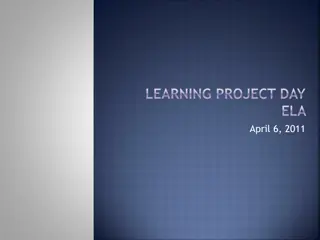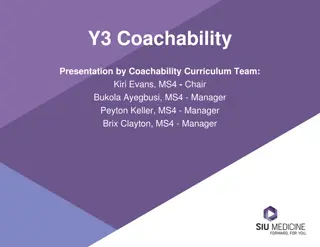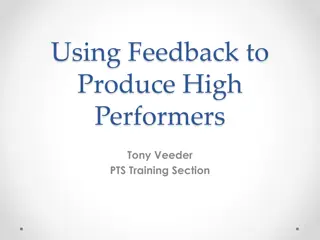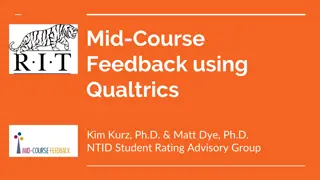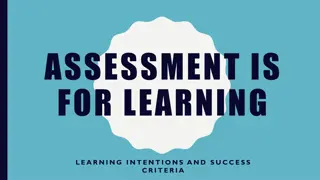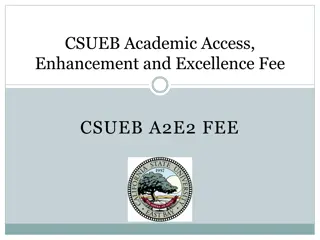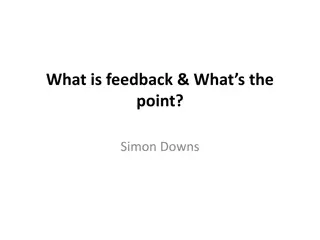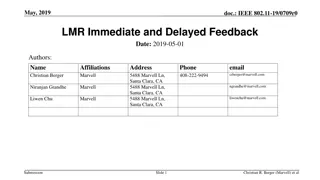Effective Feedback Strategies for Learning Enhancement
Feedback plays a crucial role in the learning process. This session focuses on strategies for providing effective feedback to improve learning outcomes, course, and assignment design, best practices, and tools for efficient feedback delivery. Understanding the importance of prompt feedback and different types of feedback in education are fundamental to enhancing student performance and fostering continuous learning.
- Feedback Strategies
- Learning Enhancement
- Effective Communication
- Education Improvement
- Learning Outcomes
Download Presentation

Please find below an Image/Link to download the presentation.
The content on the website is provided AS IS for your information and personal use only. It may not be sold, licensed, or shared on other websites without obtaining consent from the author. Download presentation by click this link. If you encounter any issues during the download, it is possible that the publisher has removed the file from their server.
E N D
Presentation Transcript
Give Feedback Effectively and Efficiently to Improve Learning March 24, 2021 Center Faculty
The Big Picture Instructor to Learner Formal and informal Written and oral feedback Occurs in discussions, classroom activities, on assignments Career encouragement and personal support Learner to Instructor asking questions about content, process and assignments Informal feedback formal avenues for mid-and end- of course feedback Learner to Learner informal study groups formal assignments in which peers provide feedback Instructor to Instructor Peer formative observation Supervisor summative evaluation
Our Learning Objectives this Session Focus on instructor to learner feedback Improve strategies for giving feedback that improves learning Course and assignment design - look for opportunities where feedback can be given Best practices for providing feedback Tools and strategies for providing feedback efficiently Why? Feedback is a vital part of the learning process
Prompt Feedback is One of the Nine Principles of Good Practice 4. Give Prompt Feedback Knowing what you know and don t know focuses learning. Students need appropriate feedback on performance to benefit from courses. In getting started, students need help in assessing existing knowledge and competence. In classes, students need frequent opportunities to perform and receive suggestions for improvement. At various points during college, and at the end, students need chances to reflect on what they have learned, what they still need to know, and how to assess themselves. https://www.cuw.edu/academics/services/faculty-staff- resources/celt/nine-principles.html
What is Feedback? Information from a teacher, peer, or other about one s performance Appreciation, coaching, evaluation (Stone & Heen, 2015: Thanks for the Feedback) Constructive, motivational, useful (Walker, 2009) Two important types in education: Formative feedback Summative feedback
Why do we give feedback? Goals To motivate, encourage Benefits To build a relationship with learner To appreciate effort or improvement To demonstrate appreciation To build self-regulation skills, to be useful So students can self-assess and self- correct To be constructive, coaching To check for understanding (formative) To improve student performance So Instructor can modify instruction as needed To foster learning Organization of content and scaffolding Follow-up on what has been built and what is coming To evaluate Tangibly assess student performance, transfer
What is Good Feedback? Feedback builds on previous knowledge Feedback asks questions to foster thinking Feedback is frequent Feedback is immediate/prompt Feedback is balanced (both positive and improvement oriented) Feedback is specific (points to what is good and needs work) Feedback is supportive (encouraging, not discouraging) Poll: What are your top 3 strengths?
CARPT Strategy of Feedback Janet Medlock Adjunct Center Faculty has taught in the OLA program for 3 years Clerk of the U.S. Bankruptcy Court for the Eastern District of Wisconsin Fun Facts: originally from Louisville, KY and has two grown sons and five grandchildren. https://cuwaa.hosted.panopto.com/Panopto/Pages/Viewer.aspx?id=e5da18 66-4fa6-476f-b7a1-ace200fd7cda
How do we give feedback? Formative/Improvement Feedback Suggestive: Recommendations for improvement at early stages of work [course design using drafts, outlines, bibliography, stages of a major assignment] Suggestions for improvement on later assignments in this course [more feedback in early assignments] Suggestions for improvement in future courses Refer students to resources which support learning Questioning: Ask clarifying questions to help the student discover their knowledge (writing to learn) Corrective: Identify errors that need correction (for resubmission) Clarify expectations and standards for the learner [design of assignments, rubrics, syllabus/course content] Summative/Evaluative Feedback To identify a grade (formal evaluation) of an assignment To explain or justify a grade
Am I stuck in the trunk??? Suggestive: Consider adding a graphic or pie chart to help support the citation of statistics. Questioning + Suggestive: What is meant by the term synthesis in this argument? If this is clarified and some additional context regarding how this fits into the main point is provided, this section will be strengthened. Questioning: What do you mean by .? How could you include ? Corrective: spelling, formatting, assignment requirements Feedback types: Leibold & Schwartz (2015) This Photo by Unknown Author is licensed under CC BY
Sharing: Where are you stuck? Corrective (this is not APA format, etc) easier than suggestive which requires deeper level questions and directing to resources "Young bear stuck in tree" by jameslyledickson is licensed under CC BY 2.0
Strategy: Prioritizing Feedback I know more about my students than I want to most of the time, to tell you the truth. It helps me talk specifically to each one, since I know them as individuals. It helps humanize them and set them apart. When I read their stories, I can be sensitive to them on their level. These stories help me know how to identify with them: who likes teasing, who wants attention, who wants to be left alone (Beach & Beauchemin, 2020). To give effective feedback you have to know your students. Then you can begin to prioritize and individualize the feedback you provide.
Prioritizing Feedback: Start Global Focus on big picture concerns Thesis Development Organization "Earth" by Meredith Garstin is licensed under CC BY-NC 2.0
Prioritizing Feedback: End Local Keep the red pen at bay Identify 1-2 reoccurring errors Model form Did they self-correct in next paper?
Strategy: Making Rubrics Work for You Provide a framework Feedback is an ongoing conversation. Before providing feedback, always assess the purpose: what do you want students to DO with this feedback? Develop meaningful rubrics that can do a lot of the work for you. Combine rubric assessment with 2-3 end comments that explain what is working in the current draft and what the student should consider for revision. Consider engaging students in the process of creating the rubric. Integrate the rubric into course activities and peer review.
Strategy: Time Limits/Think Ahead Think ahead about why feedback is needed Review the assignment instructions and expectations Read to be helpful and facilitate learning Comment limits per page, per assignment Balance with positives Give personal praise when possible Use their name for positives and you language Refer to the assignment when requesting change https://cuwaa.hosted.panopto.com/Panopto/Pages/Viewer.as px?id=18f209e1-8e78-45c4-8e76-ace60153d66f
How can I give feedback efficiently? Have a plan What is my purpose? What am I assessing? Organize Group like assignments together Don t point out every single error Point out trends to students once you point it out, can they find where else it occurs? Use your tools Trying a new tool may not feel efficient at first, but is efficient in the long run Rubrics (is there is a specific program rubric?) Audio/video feedback Inline grading in Blackboard
What feedback tools do you use? "tool box" by _sarchi is licensed under CC BY 2.0
Resources Audio/video feedback in Blackboard Rubric design (There are many, many resources available online. Here is one) Make a rubric in Blackboard Attach a Blackboard rubric to an assignment Grade using a Blackboard rubric How to use the Bb Annotate tool in Blackboard March 3 Program: Achieving Success in Timely Student Feedback
References Beach, R., & Beauchemin, F. (2020). Using writing to foster teacher/student trust. English Journal, 109(6), 30-36. Retrieved from Retrieved from https://proxy01.cuaa.edu/login?qurl=https%3A%2F%2Fwww.proquest.com%2Fscholar ly-journals%2Fusing-writing-foster-teacher-student- trust%2Fdocview%2F2428567721%2Fse-2%3Faccountid%3D10245 Leibold, N. & Schwartz, L.M. (2015). The art of giving online feedback. Journal of Effective Teaching, 15(1), 34-46. Stone, D. & Heen, S. (2015). Thanks for the feedback: The science and art of receiving feedback well. Penguin Publishing Group Walker, M. (2009). An investigation into written comments on assignments: Do students find them usable?. Assessment & Evaluation In Higher Education, 34(1), 67- 78. doi:10.1080/02602930801895752


